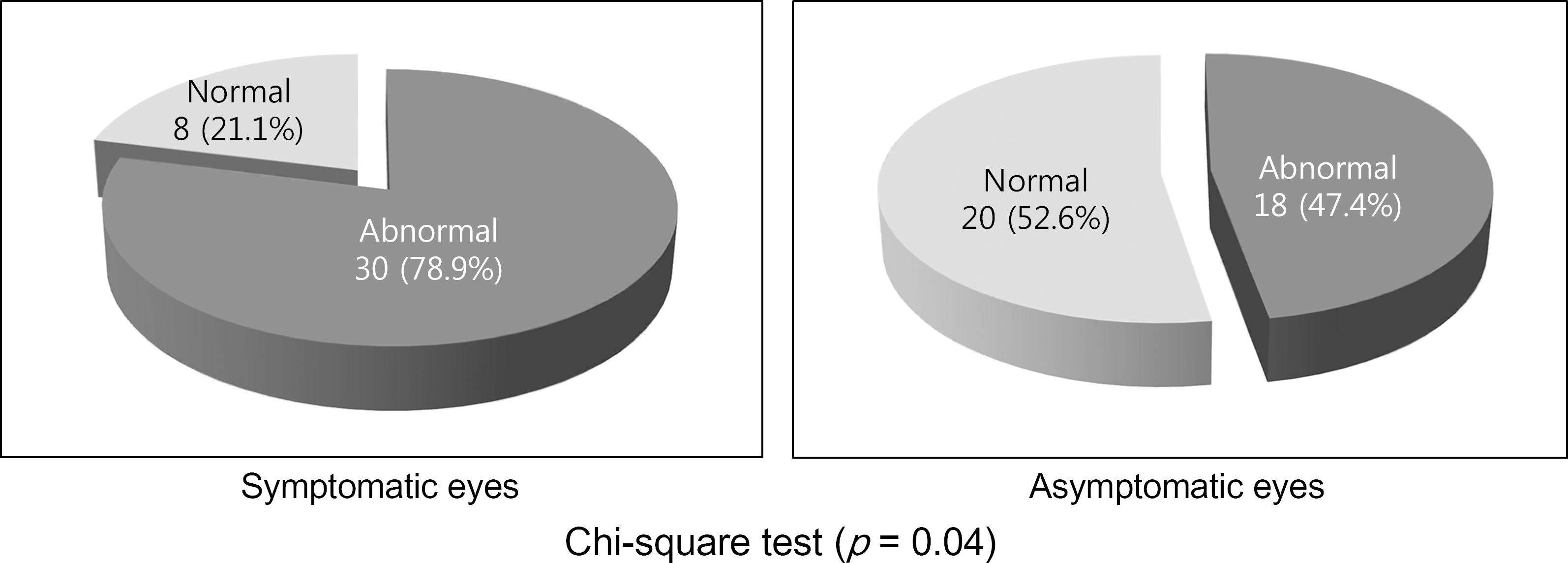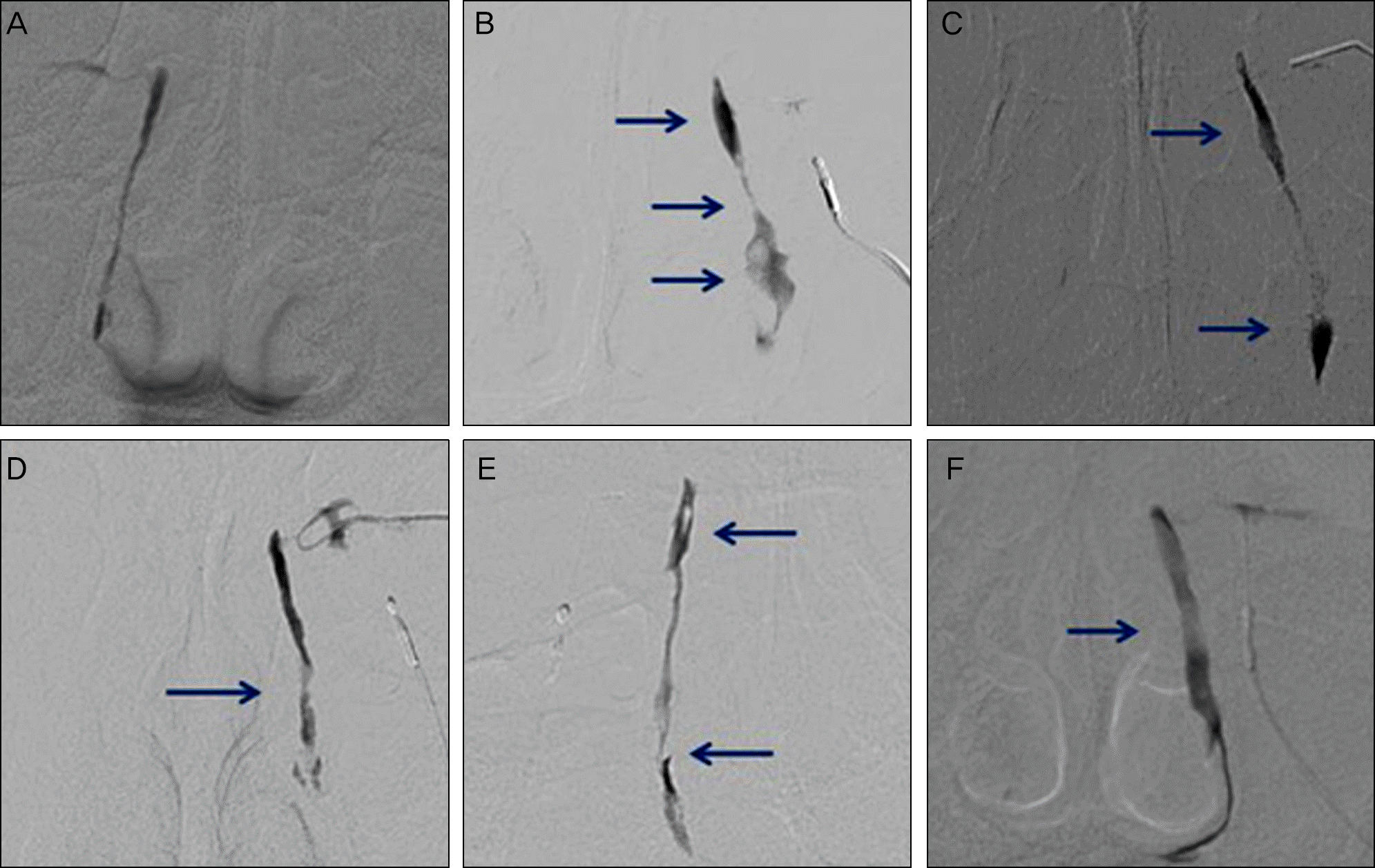Abstract
Purpose
To evaluate the morphologic change in the lacrimal drainage system using dacryocystography in patients with unilateral epiphora with patent lacrimal drainage system.
Methods
Clinical records of patients referred to our clinic for epiphora between October 2007 and August 2011 were reviewed. The study group included 38 patients who had symptoms of unilateral epiphora with patent lacrimal drainage system. The studied patients included 10 males and 28 females with ages varying between 24 and 72 years.
Results
Abnormal dacryocystographic findings in the tearing eye were 78.9% and abnormal dacryocystographic findings in the asymptomatic eye were 47.4%. Common abnormal findings included distal nasolacrimal duct stenosis, distal nasolacrimal duct dilatation and nasolacrimal sac dilatation.
Conclusions
In many cases, morphologic change in the lacrimal drainage system was observed in patients with unilateral epiphora with patent lacrimal drainage system. Dacryocystographic findings may contribute in devising a treatment plan for these patients. J Korean Ophthalmol Soc 2013;54(6):839–844
References
1. Linberg JV, McCormick SA. Primary acquired nasolacrimal duct obstruction. A clinicopathologic report and biopsy technique. Ophthalmology. 1986; 93:1055–63.
2. Roh JH, Chi MJ. Efficacy of dye disappearance test and tear meniscus height in diagnosis and postoperative assessment of nasolacrimal duct obstruction. Acta Ophthalmol. 2010; 88:e73–7.

3. Hurwitz JJ. Functional obstruction' of the lacrimal drainage passages. Chapter 20. In:. Hurwitz JJ, editor. ed.The Lacrimal System. Lippincott and Wilkins;Philadelphia, New York: 1996.
4. Kim JH, Kim JM, Woo KI. The role of dacryocystography in evaluation of nasolacrimal duct obstruction. J Korean Ophthalmol Soc. 2006; 47:1713–9.
5. O'Donnell B, Shah R. Dacrocyctorhinostomy for epiphora in the presence of a patent lacrimal system. Clin Experiment Ophthalmol. 2001; 29:27–9.
6. Zaidy FH, Symanski S, Olver JM. Endoscopic and external dacrocystorhinostomy in the management of functional epiphora. ESOPRS abstract. 2001.
7. Moore WM, Bentley CR, Olver JM. Functional and anatomic results following two types of endoscopic endonasal dacrocystorhinostomy: surgical and holmium laser. Ophthalmology. 2002; 109:1575–82.
8. Delaney YM, Khooshabeh R. External dacrocystorhinostomy for the treatment of acquired partial nasolacrimal obstruction in adults. Br J Ophthalmol. 2002; 86:533–5.
9. Sahlin S, Rose GE. Lacrimal drainage capacity and symptomatic improvement after dacrocystorhinostomy in adults presenting with patent lacrimal drainage systems. Orbit. 2001; 20:173–9.
10. Jeong HW, Cho NC, Ahn M. Result of silicone tube intubation in patients with epiphora who showing normal finding in dacryocystography. J Korean Ophthalmol Soc. 2008; 49:706–12.

11. Conway ST. Evaluation and management of “functional” nasolacrimal blockage: results of a survey of the American Society of Ophthalmic Plastic and Reconstructive Surgery. Ophthal Plast Reconstr Surg. 1994; 10:185–7.
12. Guzek JP, Ching AS, Hoang TA, et al. Clinical and radiologic lacrimal testing in patients with epiphora. Ophthalmology. 1997; 104:1875–81.

13. Irfan S, Cassels-Brown A, Nelson M. Comparison between nasolacrimal syringing/probing, macrodacryocystography and surgical findings in the management of epiphora. Eye (Lond). 1998; 12:197–202.

14. Kim C, Lew H, Yun YS. Correspondence among the canaliculus irrigation test, dacryocystography and jones test in the epiphora patients. J Korean Ophthalmol Soc. 2007; 48:1017–22.

15. Saleh GM, Gauba V, Tsangaris P, Tharmaseelan K. Digital subtraction dacryocystography and syringing in the management of epiphora. Orbit. 2007; 26:249–53.

16. Francisco FC, Carvalho AC, Francisco VF, et al. Evaluation of 1000 lacrimal ducts by dacryocystography. Br J Ophthalmol. 2007; 91:43–6.

17. Paulsen FP, Thale AB, Maune S, Tillmann BN. New insights into the pathophysiology of primary acquired dacryostenosis. Ophthalmology. 2001; 108:2329–36.

18. Paulsen FP, Schaudig U, Thale AB. Drainage of tears: impact on the ocular surface and lacrimal system. Ocul Surf. 2003; 1:180–91.

19. Ayub M, Thale AB, Hedderich J, et al. The cavernous body of the human efferent tear ducts contributes to regulation of tear outflow. Invest Ophthalmol Vis Sci. 2003; 44:4900–7.

20. Paulsen FP, Corfield AP, Hinz M, et al. Characterization of mucins in human lacrimal sac and nasolacrimal duct. Invest Ophthalmol Vis Sci. 2003; 44:1807–13.

21. Paulsen FP, Schaudig U, Maune S, Thale AB. Loss of tear duct-associated lymphoid tissue in association with the scarring of symptomatic dacryostenosis. Ophthalmology. 2003; 110:85–92.

22. Paulsen FP, Pufe T, Schaudig U, et al. Detection of natural peptide antibiotics in human nasolacrimal ducts. Invest Ophthalmol Vis Sci. 2001; 42:2157–63.
23. Paulsen FP, Paulsen JI, Thale AB, Tillmann BN. Mucosa-associated lymphoid tissue in human efferent tear ducts. Virchows Arch. 2000; 437:185–9.

24. Kim JS, Ahn M. Clinical evaluation and classification of nasolacrimal duct obstruction site by dacryocystography. J Korean Ophthalmol Soc. 2005; 46:191–5.
Figure 1.
Abnormal findings in symptomatic eyes were identified in 30 patients, whereas abnormal findings in asymptomatic eyes were in 18 patients, which proved to be statistically significant.

Figure 2.
The findings of dacryocystography in unilateral epiphora with patent lacrimal drainage system include normal (A), sac dilation (B, E), proximal nasolacimal duct dilation (C), mid nasolacimal duct stenosis (B, D), distal nasolacimal duct dilation (B, C), distal nasolacimal duct stenosis (E), and total nasolacimal duct dilatation (F).





 PDF
PDF ePub
ePub Citation
Citation Print
Print


 XML Download
XML Download